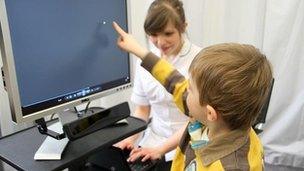Eye device to detect brain tumours launched in Edinburgh
- Published

The device can measure the visual fields of young children
A new device which can detect brain tumours and other serious conditions in vulnerable people has been launched by researchers in Edinburgh.
The device uses infra-red light, similar to that used in remote controls, to measure peripheral vision.
Problems with peripheral vision can be an early indicator of brain damage, tumours, strokes and conditions which can lead to blindness.
A prototype machine is already in use at Edinburgh Sick Kids hospital.
When you read a word on a page you are using your central vision but it is your side vision that tells you if the word is at the beginning or end of a sentence, or at the top or bottom of a page.
Your peripheral vision also tells you where to look if someone enters the room or if a car is approaching from the side.
Machines which currently test your peripheral vision rely on you pressing a button in response to moving or flashing lights, and sitting very still for several minutes.
They cannot be used on about 30% of the population.
The i2eye device, launched by the Edinburgh Bioquarter, an organisation set up to make the most of medical research, uses infra-red LEDs and a camera to record eye movement.
This means it can be used on far more people, including young children and those who would have difficulty quickly pressing a button.
Professor Robert Minns, an expert in childhood neurology at the University of Edinburgh, said: "Until now we've had no way to measure exactly the visual fields of young children.
"All we have been able to do is sit in front of them and try to see where we think they can look. This system uses a child's natural inquisitiveness."
Natural reactions
Youngsters at Edinburgh Sick Kids hospital have been tested with a prototype.
Children are asked to watch a cartoon icon on a TV screen, which can be programmed to make noises to hold their attention.
They can even sit on mum or dad's knee while the test is being carried out.
This is the first major device to be launched by the Bioquarter.
Peter Estibeiro, chief executive officer of i2eye diagnostics, said: "The eye tracker unit is watching your eyes, using your natural reactions to movements on the screen so it can build up a standard visual field map.
"We would expect it to be useful in most children's hospitals and eye hospitals."
- Published1 November 2011
- Published30 October 2011
- Published8 June 2011
- Published20 September 2011
- Published11 February 2011